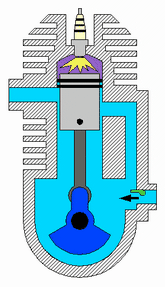Working Principle of 2-stroke engine
- The whole process i.e. Suction, compression, power and exhaust is completed in two strokes of piston and one complete revolution of crankshaft.
- There is no valve.
- Gas movement takes place through holes called ports of the cylinder.
- The crankcase is gas tight in which the crankshaft rotates.

A) First stroke (Suction+ Compression)
- Piston moves up the cylinder and covers two ports i.e. exhaust and transport port.
- This traps a charge of fresh mixture in the cylinder and further upward movement of piston compresses this charge.
- Further movement of piston uncovers suction port and more fresh mixture is drawn into the crankcase.
- Just before the end of this stroke, the mixture in the cylinder is ignited.
B) Second stroke (Power+ Exhaust)
- The burning of gases increases pressure in cylinder and forces the piston to move down the cylinder.
- When piston moves down, it covers and closes the suction port, trapping the mixture drawn into the crankcase.
- Further downward movement of piston uncovers first the exhaust port and then the transfer port.
- This allows the burnt gases to flow out through exhaust port.
- The fresh mixture under pressure in crankcase is then transferred into the cylinder through transfer port during this stroke.